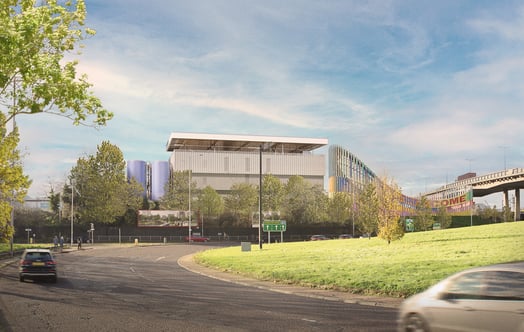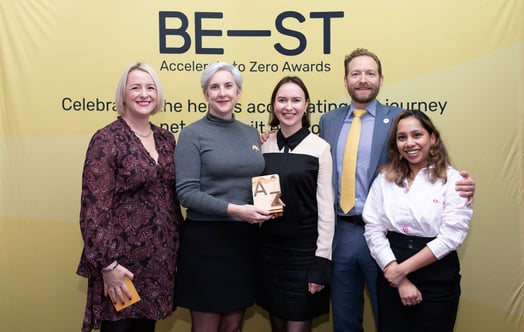
Getting the right technology in the right place: Understanding fourth and fifth-generation heat networks
When people talk about the future of low-carbon heating, the conversation can often turn to “generations” of heat networks, and most recently, to the promise of fifth generation systems. But as with most infrastructure, there’s no one-size-fits-all answer.
At Vattenfall, our experience in developing a citywide heat network in Bristol has shown that choosing between fourth and fifth generation heat networks is all about getting the right technology in the right place.
What’s the difference?
In simple terms, a fourth-generation heat network delivers low-temperature hot water, typically around 65–75°C, through insulated pipes to buildings connected to the system. The heat is often produced centrally by large heat pumps or other low-carbon sources and then distributed to homes, offices, and public buildings.
A fifth-generation heat network works differently. It moves heat at much lower temperatures, sometimes close to the temperature of the air outside. It also relies on each connected building having its own reversible heat pump to raise or lower the temperature for heating or cooling. So, it is not an evolution of heat networks in the way we might recognise a fifth-generation phone to be “better” than a fourth-generation phone.
In theory, it’s an elegant solution: buildings that need cooling can send heat into the network, and those that need heating can draw heat from it. But in practice, it’s not always that straightforward.
Why fourth-generation fits Bristol
Vattenfall is working as part of Bristol City Leap (a twenty-year joint venture partnership between Bristol City Council, Ameresco and Vattenfall) to deliver a citywide, resilient heat network that serves the community with low carbon heat, creates jobs and boosts the economy in Bristol.
Our fourth-generation heat network solution in Bristol, developed jointly with Bristol City Council, is guided by detailed studies of each area’s building stock, heat demand, and development plans. In city centre areas, installing pipework is challenging and expensive. As fifth generation systems require much larger pipes to move lower-temperature water, the cost and disruption would rise sharply. This is a poor fit for busy streets and constrained underground spaces.
Most of the areas we’re connecting have a higher demand for heating than cooling. The most urgent priority is to decarbonise heat, while cooling will naturally decarbonise as the electricity grid moves towards net zero. In such conditions, a fourth-generation system provides the right balance between performance, cost, and carbon savings.
Design, space and operational considerations
From a developer’s point of view, every square metre counts. A fifth-generation network would mean every building needs its own heat pump, more plant room space, and higher electrical capacity. It also adds complexity in day-to-day operation and maintenance. That can work for new builds designed around the technology, but it’s much harder for existing buildings with limited space or electrical headroom.
With our fourth-generation network, the complexity is centralised at a few large energy centres rather than multiplied across hundreds of buildings. This brings efficiency of scale: simpler interfaces, less equipment in buildings, and more predictable performance. Our approach also allows us to keep tariffs consistent. Because the network runs at a single efficiency level, all customers benefit from the same, fair pricing structure.
Managing balance and long-term performance
A key challenge with fifth-generation systems is maintaining a perfect balance between heating and cooling demand. If one large office becomes student accommodation, and needs heating instead of cooling, the balance can tip and the network’s efficiency can fall sharply. That makes long-term performance uncertain, especially in mixed-use urban developments where future occupancy can change.
In contrast, a fourth-generation network can offer stability and flexibility. Central energy centres can be adapted over time, with additional heat pumps or waste-heat connections added as the city evolves. In Bristol, we’re already planning for future connections, for example, we are planning to start recovering excess heat from developments like Bristol University’s Temple Quarter Enterprise Campus which will add further resilience to the heat network. Where there’s a cluster of buildings with genuine cooling needs, we can install local cooling loops that feed heat back into the main system.
The right mix for a low-carbon city
It is not about one technology being “better” than the other. Fifth-generation networks can make sense for self-contained sites where the heating and cooling loads are predictable and balanced. For most city-scale systems, especially where many existing buildings are involved, fourth-generation networks remain the most practical and reliable way to decarbonise heat at scale. The two can also co-exist, with a campus fifth- generation network working in tandem with a fourth-generation area wide network.
At Vattenfall, our focus is on building flexible, future-ready networks that can integrate both fourth and fifth-generation systems where they make sense. By matching the technology to the place and not the other way around, we’re helping cities like Bristol move faster towards a net zero future without compromising performance, cost, or reliability.



